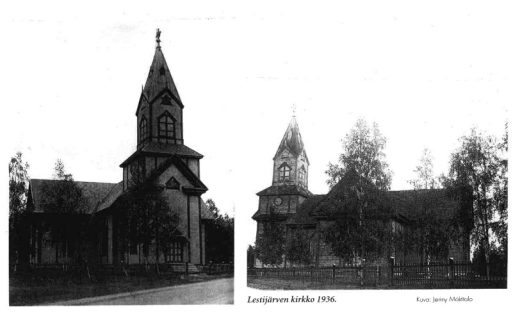Churches in Lestijärvi

First Church
The history tells the first church could have been a small so called sacrificial church or a shrine in a catholic manner. Already in the Middle Ages there were soldiers in the areas who might have used the church built in the wilderness. Lestijärvi was part Sweden and Russia´s border area of which the countries were constantly fighting. Perhaps the king Kustaa VIII Knuutinpoika´s journey to Lestijärvi in 1466 was an inspection of the border areas and the troops patrolling the area. The piece De Ostrobothnia mentions that a forecastle was build to Reisjärvi in 1656 to prevent Russians attacs Finnish areas. A story tells that in the forecastle in Reisjärvi lived a warlord called Jochum con Dol whose daughter was stolen by another warlord called Morolf who lived in Lestijärvi.
Church Island
The second church was possibly located in Church Island in front of Tuikka village. There is very little information of the church but it has most likely been a small shrine as its predecessor.
The name of the island indicates that Church Island has either served as a location for church service or as a temporary cemetery before moving the dead to the actual cemetery. Another explanation is that in the old days, there was a little church on the island. The most probable explanation is that the island served as a cemetery and therefore it was named after its connection with the church.
These days there is a little chapel on the island as a memorial of the previous generation´s hard work and it is a place of quiet and peace for the people moving in the waters nowadays. The chapel was a donation from Pentti and Väinö Laakso. In front of the chapel, there are benches and a wooden cross. In the chapel, there is an altar piece that says: “Tämä on varmaan Jumalan asuinsija ja itse taivaan portti. 1 Moos. 28” which means:” This must be God´s home and the gate to heaven. “
Church island welcomes both locals and visitors to stop and take a break from the busy world.
History of the Church Island
Historical findings have been made in the Church Island. There are five holes that refer to the Bronze or Iron Age and to animal hunting and processing in those eras, but the island has not been further examined to determine the age or purpose of the holes. A well preserved, ball shaped mallet has been found from the island and it can be traced back 7000 years, all the way to the Mesolithic Period. This mallet´s purpose in history has remained unclear in all of Finland but it is suspected that they have been used in hunting seals or as additional weight when breaking the ice of the lake.
Änäkkälä Church
The third church so called Änäkkälä Church was located approximately three kilometres from the town centre of Lestijärvi towards Kinnula in a village called Änäkkälä. This church was still in use in 1820s and the location of the church is still surrounded by a stone fence. The church pulpit was received as a donation from Veteli in 1685 and after serving the congregation it was moved to the Finnish National Museum´s storage in Suomenlinna. Änäkkälä Church was repaired in 1754 and due to its smallness – it could only fit 80 persons inside – it was reaching the end of its days. The crowdness of the church was made worse by the residents of Kinnula who also came to Lestijärvi for church as it was closer than Viitasaari.
Lestijärvi Church (current)
It was decided that Lestijärvi church the so called forth church would be build in Lapinmäki to a sand esker, near the Lestijärvi beach. To build the church an application for the king was drafted in a church meeting 21.03.1804. The preliminary blueprints was drafted by the famous Heikki Kuorikoski (1772-1846) from Kaustinen who has built many other churches as well. The blueprints were not accepted in the office of the royal high-intendant in Stockholm but they had new blueprints made by G. af Sillen. These blueprints were not accepted either because he had located the windows almost to the level of the eaves. He thought as much that his plan for the windows would raise questions but justified his plan by saying that “the higher and wider the windows the more the eyes and thoughts rise up. Church also is not a society house or a common living space, where the buildings environment should be seen. The draft of air from the windows should also be taken into consideration.”
Executing the building plan of the church took 20 years due to lack of funds. Not until 1827 the residents of Lestijärvi saw the new church being finished with the leadership of Heikki Kuorikoski. The inauguration of the church was 23.09.1827 and it was performed by Carl Gustaf Elfving, who described the inauguration ceremony as follows: “the women cried but the men were trading horses.”
Renovations and repairs
Over the years the following repairs to the church has been made: moving the bell tower, raising the windows and shaping them to pointy end windows from the top. The roof ridge has been lifted to make the rooftop steeper. In 1935 the church got a shingle roof and in 1952 architect Niilo Mattila designed the organ loft. At the same time the church was lined, benches renewed and windows doubled. The wood heated stoves brought heat to the church and at the same time the electricity drawn and the church was painted from inside. Since then the church has been connected to district heating. The church roof has been coated with tar multiple times and in 1963 the coating was executed by the vicar and the police. The last time the roof was coated with tar was in 2020.
The church has gone through many repairs, that has been made to improve the safety of the church. The latest outside painting was made in 2001. When painting the church a paint layer from each era has been preserved in sight. The church used to be on timber base without paint because of poverty.
The church can fit 400 persons inside. The church has been considered as beautiful but modest. In front of the church there is t-loop for the hearing disabled. Today it is possible to watch the service on your computer no matter where in the world you live.
The church altarpiece, instruments and Wooden Paupers
The altarpiece of the Lestijärvi Church has been painted by 18-year-old Beata Ekelund and it expresses the Lord´s ascension. The altarpiece is gentle by colour and light by nature compared to many altarpieces with dark subjects. The colouring fits to Lestijärvi Church´s colours and the altarpiece is also unique because it was painted by a young woman, which was very rare at that time.
The pulpit that Heikki Kuorikoski made at the same time with the church is simple but beautiful. The church instrument until 1962 was a harmonium and after that electronic organ. It was decided that 8 organ stop organs would be purchased from Hans Heinrich in Maksamaa. The echo base of the church piano was made out of the old floorboards of the church.
The first mention of the Wooden Pauper is in 1840. Its history is still a little unclear. It is considered as “nobility of wooden paupers” as it was in a “Finnish wooden paupers” exhibit in Nordic Museum in Stockholm. Its second visit was to an exhibit in Helsinki Cathedral´s crypt. In both of of the exhibits it was said that there is something special in the wooden pauper of Lestijärvi. Later on the wooden pauper has also paid a visit to an exhibit in Seinäjoki.
Source: Pentti Laasanen
More information: www.toholamminseurakunta.fi

